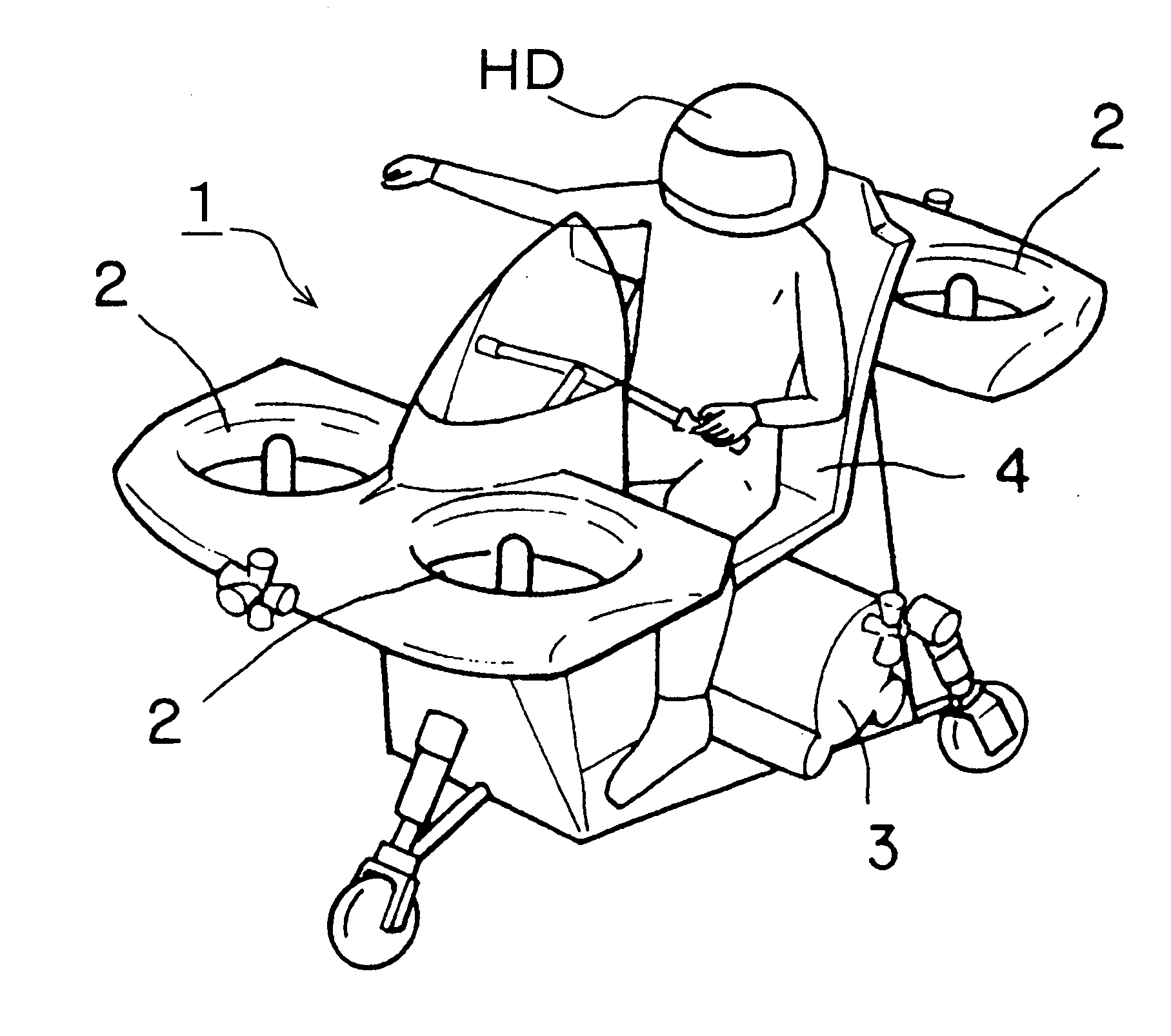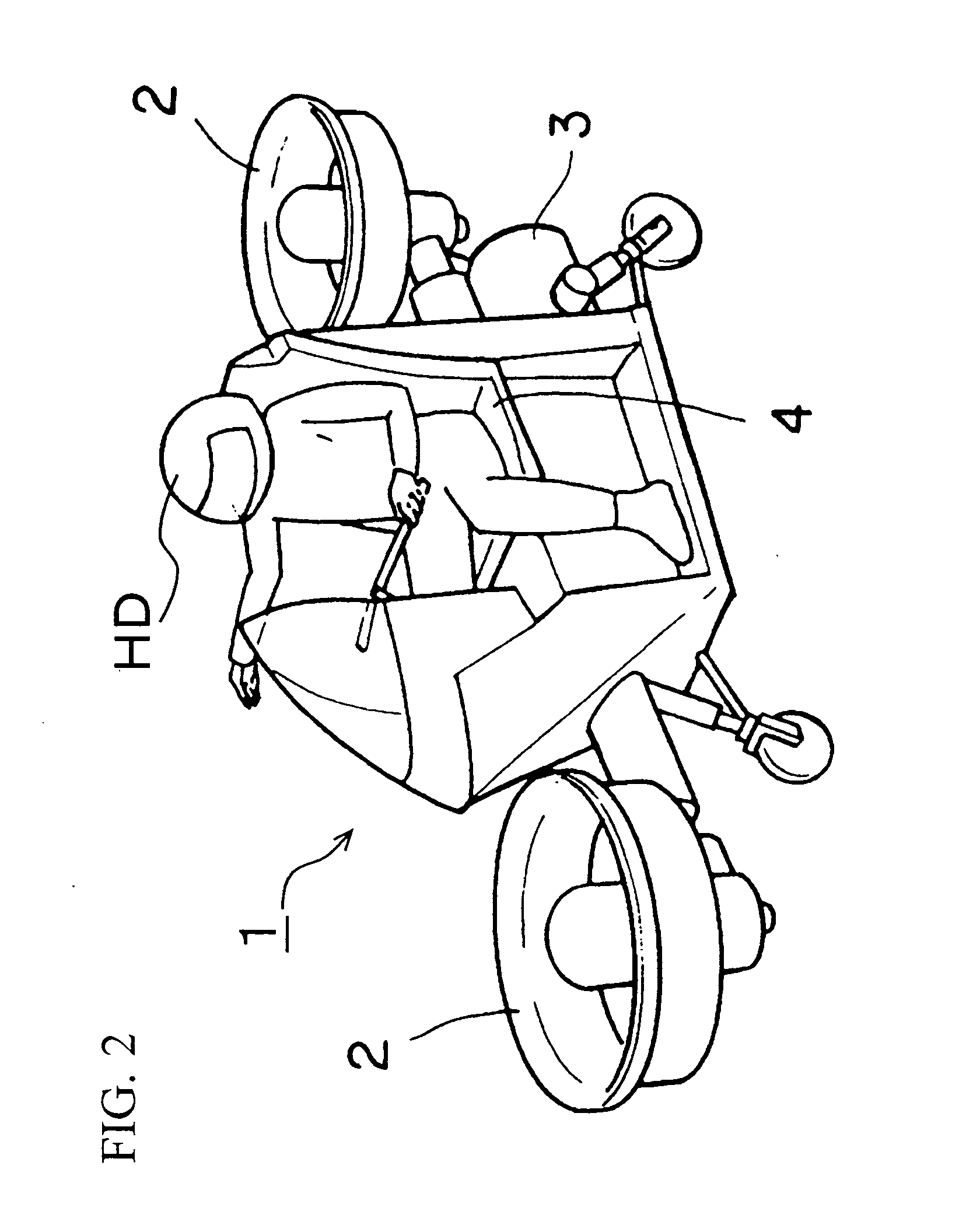Vertical take-off and landing aircraft
a vertical take-off and landing technology, applied in vertical landing/take-off aircraft, aircraft navigation control, transportation and packaging, etc., can solve problems such as failure at a portion, non-uniform temperature distribution, and engine load change, and achieve high responsiveness
- Summary
- Abstract
- Description
- Claims
- Application Information
AI Technical Summary
Benefits of technology
Problems solved by technology
Method used
Image
Examples
embodiment 1
[0036] FIGS. 1 to 3 schematically show the structure of vertical take-off and landing aircrafts 1 according to the present invention. The embodiment that will be described below is to be applied to these vertical take-off and landing aircrafts 1. The vertical take-off and landing aircraft 1 shown in FIG. 1 is equipped with four tip turbine fans 2, two of which are provided in the front side of the operator HD and the other two of which are provided in the rear side of the operator HD. Compressed air used as drive source of these tip turbine fans 2 is stored in a compressed air tank 3 disposed below the operator seat 4 for the operator HD. The vertical take-off and landing aircraft 1 shown in FIG. 2 is equipped with two turbine fans 2, one of which is provided in the front side of the operator HD and the other of which is provided in the rear side of the operator HD. Compressed air used as drive source of these tip turbine fans 2 is stored in a compressed air tank 3 disposed in the r...
embodiment 2
[0041]FIG. 6 schematically shows a vertical take-off and landing aircraft according to the second embodiment. The basic structure of the vertical take-off and landing aircraft 1 shown in FIG. 6 is the same as the vertical take-off and landing aircraft shown in FIG. 1. What is different is that the tip turbine fan 2 of the vertical take-off and landing aircraft shown in FIG. 6 has two fans that is arranged in series one above the other. The rotation directions of fans in each tip turbine fan 2 are opposite to each other as indicated by solid arrows in FIG. 6. A more detailed structure of the tip turbine fan 2 of this embodiment is shown in FIG. 7. In FIG. 7, elements the same as the elements of the tip turbine fan 2 shown in FIG. 4 are designated by the same reference numerals, and detailed descriptions thereof will be omitted.
[0042] A difference between the tip turbine fan 2 shown in FIG. 7 and the tip turbine fan 2 shown in FIG. 4 resides in that the former has two fans (10a and 1...
embodiment 3
[0047]FIG. 8 shows the structure of a system related to compressed air supply in a tip turbine fan 2 of a vertical take-off and landing aircraft 1 according to this embodiment. FIG. 9 shows the structure of the tip turbine fan 2 in detail. The specific structure of the tip turbine fan 2 is the same as that shown in FIG. 7, and the same components are designated by the same reference numerals, and detailed descriptions thereof will be omitted. To facilitate description, in FIG. 9, the elements in the right side of the rotation axis SL of the main shaft 17 are designated by reference numerals to which “R” is suffixed, and the elements in the left side of the rotation axis SL are designated by reference numerals to which “L” is suffixed.
[0048] As shown in FIG. 8, the tip turbine fan 2 of this embodiment has twelve compressed air intake ports 14 leading to the turbine chamber 15. To each compressed air intake port 14, a compressed air supply passage 6 for supplying compressed air from ...
PUM
 Login to View More
Login to View More Abstract
Description
Claims
Application Information
 Login to View More
Login to View More - R&D
- Intellectual Property
- Life Sciences
- Materials
- Tech Scout
- Unparalleled Data Quality
- Higher Quality Content
- 60% Fewer Hallucinations
Browse by: Latest US Patents, China's latest patents, Technical Efficacy Thesaurus, Application Domain, Technology Topic, Popular Technical Reports.
© 2025 PatSnap. All rights reserved.Legal|Privacy policy|Modern Slavery Act Transparency Statement|Sitemap|About US| Contact US: help@patsnap.com



